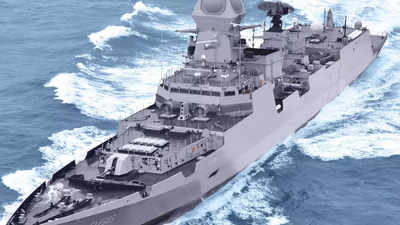- News
- India News
- Navy wants to become 170-warship force in 10 years
Trending
This story is from November 16, 2021
Navy wants to become 170-warship force in 10 years
The Navy aims to achieve its target of becoming a 170-warship force in another decade, even as it pushes for the conclusion of the tri-Service case for 30 armed MQ-9B Predator drones by next year as well as a third aircraft carrier in the years ahead, in the face of the collusive threat from China and Pakistan.

Indigenous destroyer to be commissioned as INS Visakhapatnam on Nov 21
“We live in a time when global and regional balances of power are shifting rapidly and the region of most rapid change is undoubtedly the Indian Ocean Region (IOR).

The procurement case for the 30 armed MQ-9B Predator drones from the US “will move in a short while” for approval to the Rajnath Singh-led defence acquisitions council (DAC) after ongoing consultations with all the stakeholders for a “balanced decision”, Vice Admiral Ghormade added.
TOI was the first to report that India had finalized the plan to acquire the drones -- 10 each for the Army, Navy and IAF -- for long-range precision strikes against hostile targets on land and sea. The deal includes some technology transfer as well as repair and maintenance facilities to be set up in India. After the Cabinet Committee on Security’s final nod, the government-to-government deal with the US is likely to be inked next year.
The Navy, meanwhile, is set to get a major boost in combat power with the commissioning of the first of the four Visakhapatnam-class guided-missile destroyers (overall project cost Rs 35,000 crore) on November 21 and the fourth of the six Kalvari-class Scorpene submarines (Rs 23,000 crore) on November 25.
“Both built at Mazagon Docks at Mumbai are major milestones showcasing the Indigenous capacity to build complex combat platforms. They will enhance our capacity and firepower to address threats both in the above water and underwater domains,” Vice Admiral Ghormade said.
“It’s a matter of immense pride that as many as 39 warships and submarines are currently being constructed in various Indian shipyards (in addition, two frigates are being built in Russia),” he added.
But the earlier plan for the 130-warship Navy, with around 230 aircraft, helicopters and drones, to reach the figure of 170 warships and 320 aircraft by 2027 has been deferred by at least five years due to delays in acquisition plans and budgetary constraints.
This becomes all the more worrisome because China, which already has the world’s largest Navy with around 350 warships and submarines, has now also begun to supply Pakistan with four multi-role stealth frigates and eight Yuan-class conventional submarines with air-independent propulsion for great underwater endurance, among other naval platforms and weapons, under deals worth over $7 billion inked earlier.
The Indian Navy had factored “all such threats from adversaries across the entire spectrum of warfare” into its mission-based, capability-dominant development plan. A third aircraft carrier “fits into this balanced force structure”, said the Navy vice chief.
India currently has only one aircraft carrier, the 44,500-tonne INS Vikramaditya, inducted from Russia for $2.33 billion in November 2013. Another $2 billion was spent on procuring 45 supersonic MiG-29K fighters to operate from its deck.
The country’s first indigenous aircraft carrier will be commissioned as INS Vikrant in August next year. But the 40,000-tonne carrier will become fully operational only after the requisite fighter and helicopter trials are completed from its deck by around mid-2023, as was earlier reported by TOI.
China already operates two carriers, Liaoning and Shandong, and is fast building two more with CATOBAR (catapult assisted take-off but arrested recovery) configuration to launch fighters as well as heavier aircraft for surveillance, early-warning and electronic warfare from its deck, like the US ones.
End of Article
FOLLOW US ON SOCIAL MEDIA










